The evolution of traditional costumes and textiles within the Bhotia tribe of Uttarakhand is a dynamic process influenced by a variety of social factors. These factors impact the preferences, needs, and cultural perspectives of the people, leading to the continuous transformation of their clothing and textile traditions. This interaction with modernity has given rise to contemporary attire that coexists with the traditional, sometimes causing the latter to recede into antiquity. This study aims to document the traditional clothing, textiles, and accessories of the Bhotia tribe, with a particular focus on the Uttarakhand Bhotia sub-group.
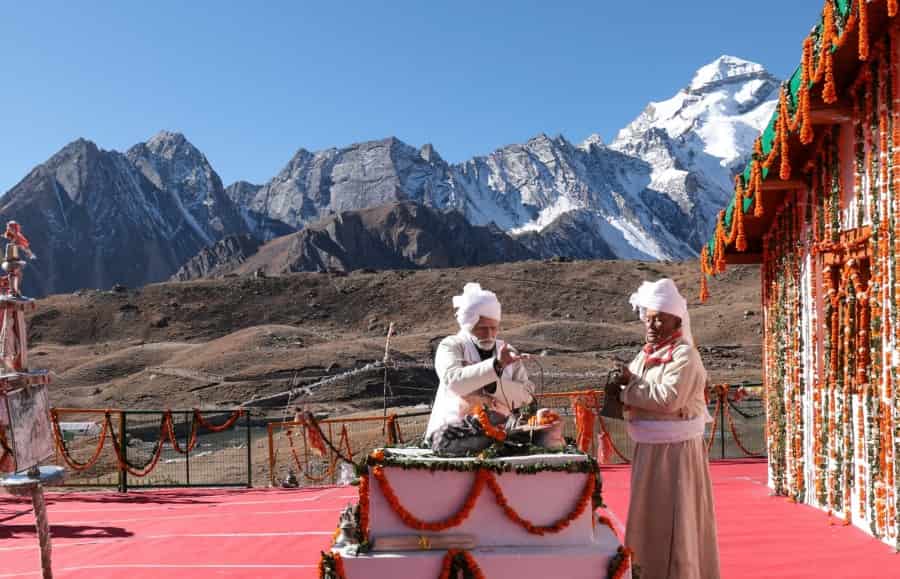
Evolution of Costumes
The attire of any culture provides a visual representation of its unity and societal structure. Beyond mere functionality, clothing has come to symbolize personal identity, religious beliefs, and social status. It is essential to recognize that the initial impulse for clothing stemmed from the need for protection and coverage, primarily against natural elements. Over time, it transitioned into a means of personal adornment and cultural expression.
According to historical records, the concept of upper garments emerged after the invention of skirts. The introduction of clothing, in particular, a skin draped over the shoulders, might have sparked the craze for specialized attire among tribes. This desire for unique garments led to the symbolism of dress as an emblem of dignity, distinction, and status. The evolution of clothing patterns found its way into ancient river valley civilizations, such as the Egyptians, who left records of their costume traditions.
The Diversity of Indian Clothing
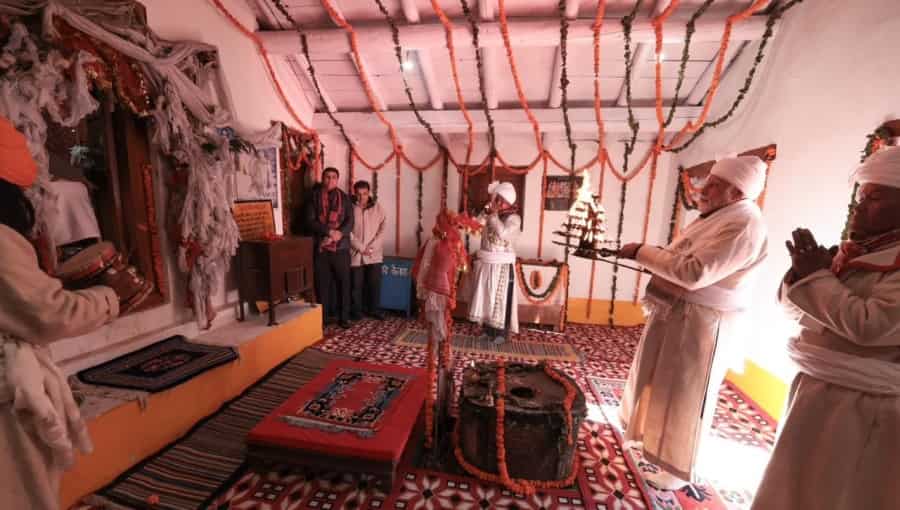
India boasts a rich tapestry of culture, tradition, and art, reflected in various aspects such as clothing, textiles, and embroidery across different regions. The diversity in clothing styles in India is influenced by factors like ethnicity, geography, climate, and cultural practices. Over time, traditional attire has transformed from basic garments like kaupinam, langota, dhoti, and saree to intricate costumes suitable for daily wear, festive occasions, rituals, and dance performances. This diverse array of clothing in India incorporates a fusion of traditional and Western styles.
The Cultural Wealth of Uttarakhand
Uttarakhand, one of India’s states, is renowned for its distinct culture and the presence of various ethnic groups. Among these, the Bhotia tribe holds a special place, preserving age-old traditions and lifestyles. The Bhotia tribe includes several sub-groups, but this study primarily focuses on the Uttarakhand Bhotia.
Tribal arts and crafts in Uttarakhand are rich and diverse, representing the cultural mosaic of its people. Officially, Uttarakhand is home to approximately five tribes, each with its unique dressing patterns and cultural heritage. The traditional textiles and accessories of these tribes stand as remarkable expressions of beauty and tradition.
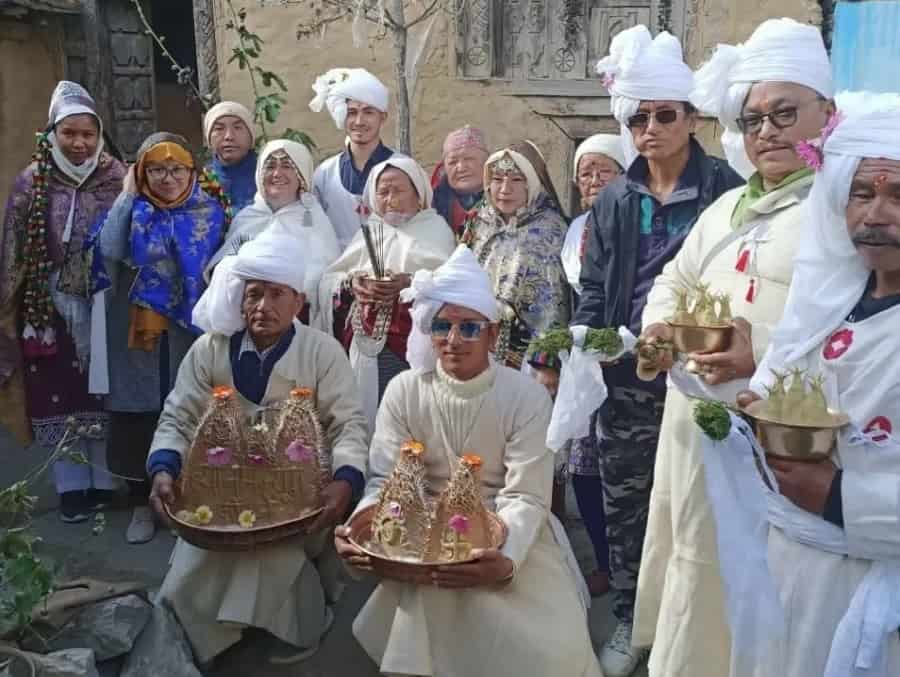
Preservation of Tribal Lifestyle
The tribal lifestyle of the Bhotia people has remained relatively unchanged over the years, ensuring the endurance of their traditional clothing and textiles. These attires are well-suited to the region’s climate and their way of life. The preservation of traditional apparel is crucial, as it symbolizes tribal identity. The rich traditions of Indian tribal textiles have contributed to their continued growth and beauty, even in contemporary times.
This documentation endeavor seeks to unveil the intricacies of traditional Bhotia clothing and textiles. It aims to shed light on the raw materials used, designs, the current state of these garments, and their overall survival. Additionally, it serves as a valuable resource for future researchers. As the government places increasing emphasis on preserving traditional arts and crafts, this study aims to promote the traditional crafts of the Bhotia tribe, exploring ways to blend their distinctive clothing style with modern attire.
Traditional Female Costumes of the Bhotia Tribe
Women of the Bhotia tribe adorned themselves in a variety of traditional garments, including Honju, Chhua, Pangden, and Ghagra. The attire of the Bhotia community reflects a blend of Bhotia and Tibetan cultures, often crafted within the confines of their own homes. The key components of traditional female Bhotia attire encompass:
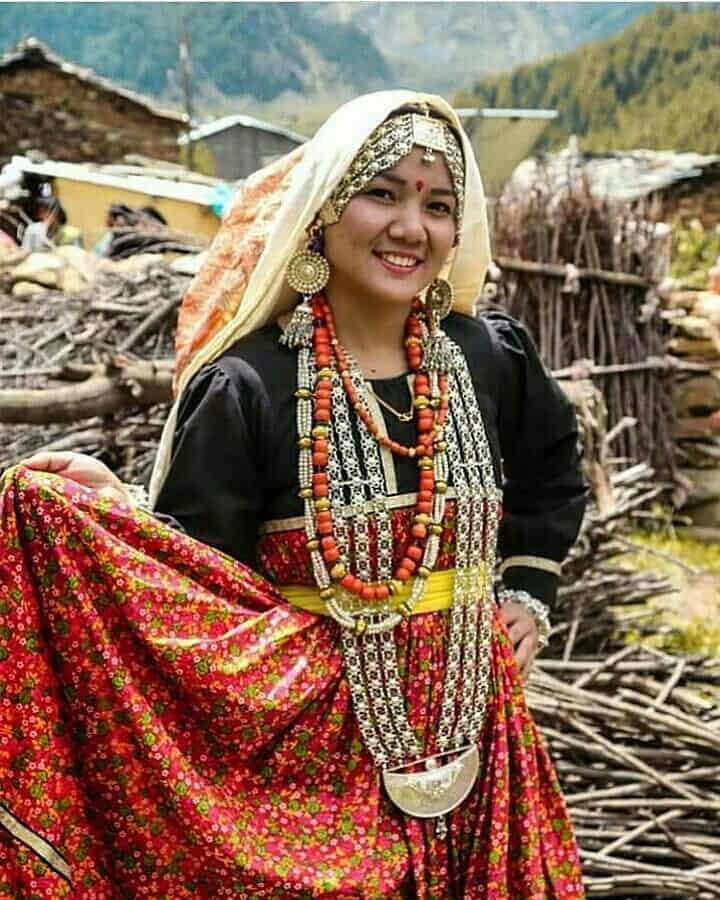
Honju – Honju serves as the primary and enduring piece of clothing for Bhotia women, with minimal alterations to its design over time. This garment is an adapted version of the ancient Indian upper garment known as “Choli,” which evolved by incorporating features of the British “Blouse” introduced to India by British women. Honju is a waist-length blouse-like garment typically made from silk fabric, though printed cotton is occasionally used. It features a front opening for ease of wearing, fastened with small buttons that often match the garment’s color. In the cold climate, Honju usually has a low round neckline but may occasionally feature square shapes, low necklines, or collars. Darts are added to provide fullness at the bust. While silken Honju has full sleeves, a three-quarter length is more common to allow movement during work in harsh conditions.
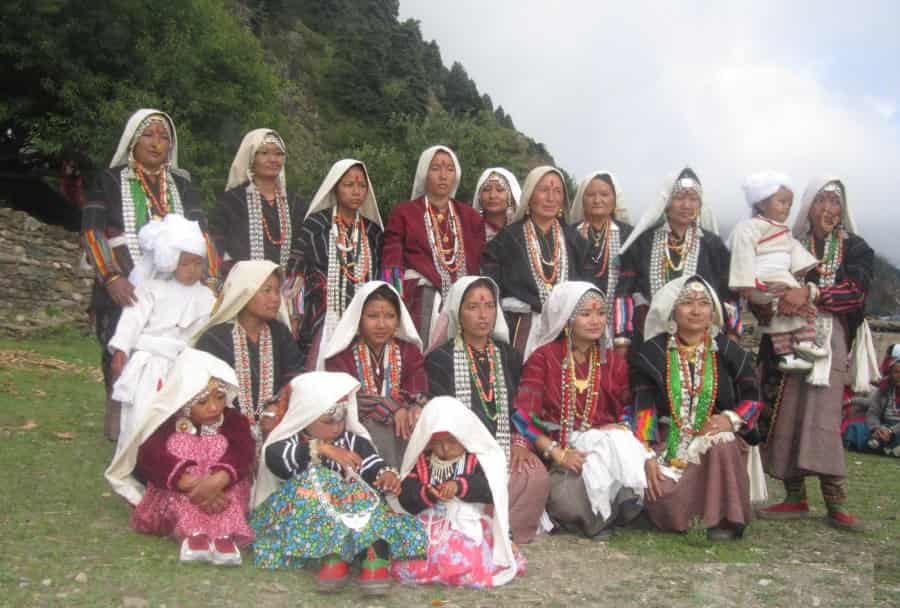
Chhua – Chhua is a loose gown-like garment, primarily constructed from woolen fabric. It is a dark-colored wrap dress secured around the waist with a belt. Chhua is ankle-length and sleeveless, with a front closure featuring a V-shaped deep neckline or a flat collar. This garment is worn over the Honju blouse and allows the sleeves of the blouse to be visible. Chhua is often made from a plain-colored fabric, with a colorful striped cloth worn on top to enhance its appearance.
Pangden – Pangden is considered the traditional and principal attire for married women. Resembling an “Apron,” it is tied at the waist and extends to the calf. Pangden is crafted from multicolored woolen cloth and worn on the front. The garment is adorned with vibrant geometric designs typically worn by married women. A long piece of cotton or silk cloth known as a “kamarband” is tied at the waist to complete the ensemble.
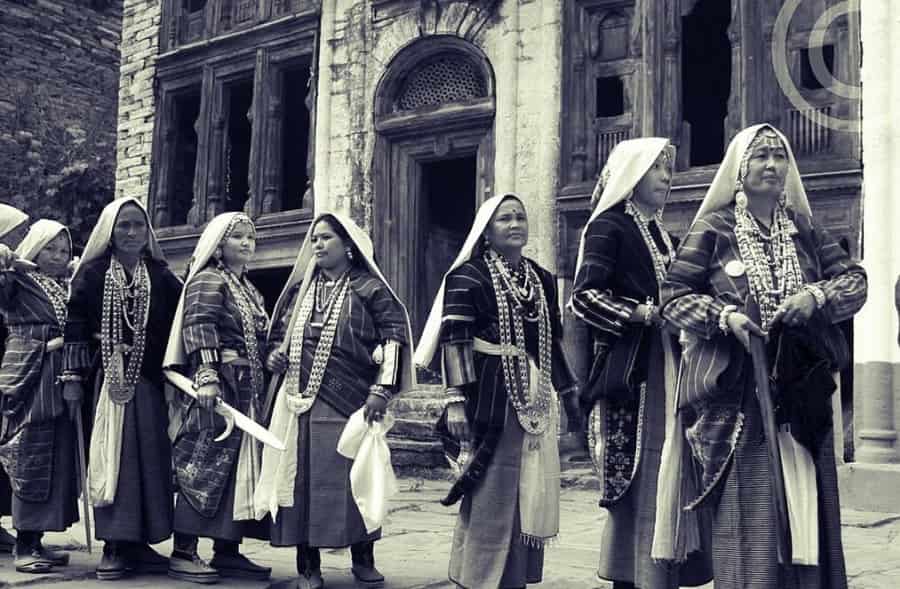
Ghagra – Ghagra is the traditional lower garment worn by older women of the Bhotia tribe. This skirt-like attire extends from the waist to the ankle and has a circular silhouette with ample fullness. It is typically made from 3-4 meters of fabric. The waist is cinched with a belt through which a string is passed and tied to adjust the fullness using gathers. The lower edge of the garment is often finished with a pleated narrow band of the same material. This piece is usually paired with the Honju blouse, and some women continue to wear it during ceremonies.
Traditional Male Costumes of the Bhotia Tribe
Bakhu – The traditional dress worn by Bhotia men is known as the Bakhu. It is reminiscent of the Tibetan chuba, but it lacks sleeves. The Bakhu is a loose-fitting cloak-like garment that is fastened at the neck on one side and around the waist using a silk or cotton belt. Men typically pair the Bakhu with loose trousers. This traditional attire is often complemented with intricately embroidered leather boots, a choice made by both men and women. Beneath the Kho (Bakhu), Bhotia men typically wear a double-breasted, high-necked shirt.
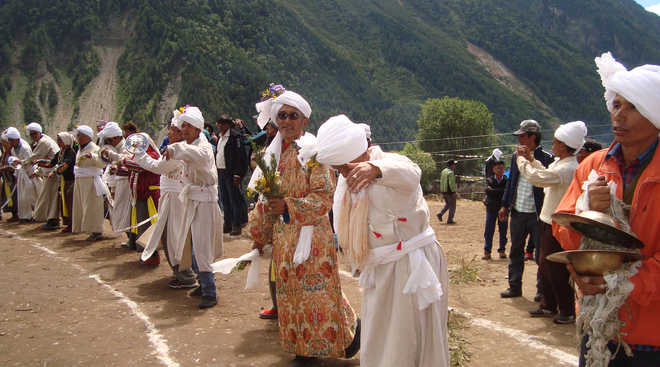
Chhuba – The Chhuba is another traditional male costume. It consists of a long, roomy robe with wide, elongated sleeves that extend nearly to the ground. This robe is cinched at the waist with a woolen girdle, allowing the lower part of the garment to reach only to the knees. The upper folds of the Chhuba create a large circular pocket around the wearer’s chest, known as the ampa. This pocket is used to carry a variety of items, including an eating bowl, a bag, and other small necessities. Many Chhubas are made from wool, often using plain gray or undyed white wool, which is the natural color of sheep’s wool.
Accessories
Accessories among Bhotia women are relatively minimal but serve functional and aesthetic purposes. These include:
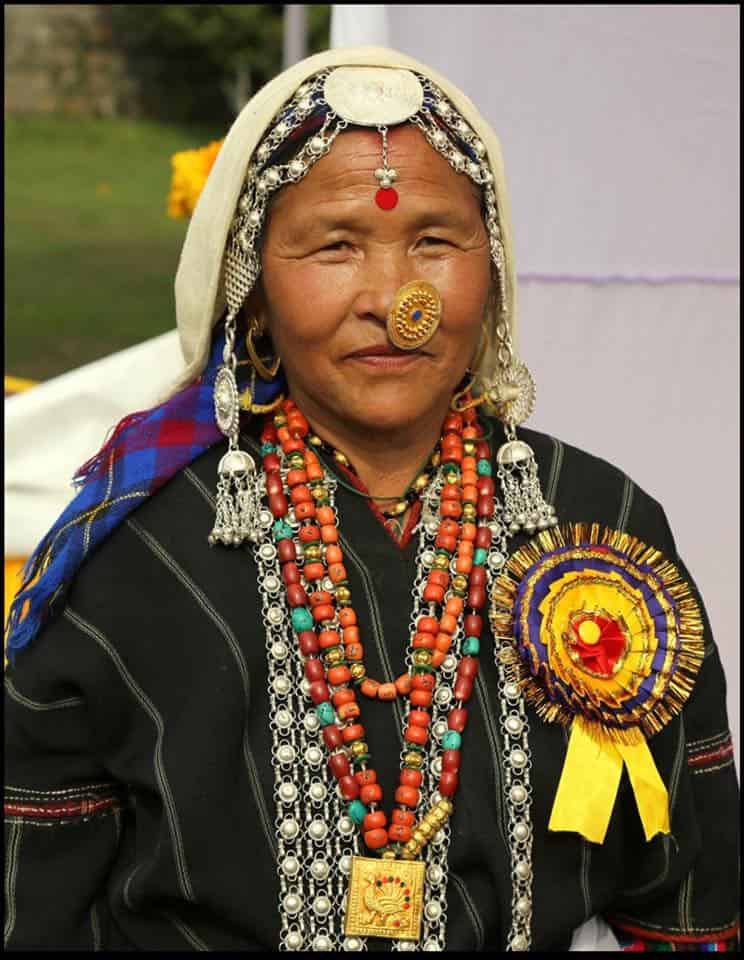
Purses: Hand-stitched purses are used to store money and personal belongings. They are typically crafted from old, discarded fabrics.
Wristwatches: A few fortunate Bhotia women may own wristwatches, which they cherish and protect.
Sticks: Elderly women may carry walking sticks for support during mobility. These sticks are functional rather than fashionable.
Jewelry: Bhotia women favor earrings and neck ornaments. Necklaces, such as CHURRU, KHOU, MUNGA FROJU, FASO, often feature semi-precious stones like Mani, Yu, gold, and silver. These adornments hold deep cultural and symbolic significance, contributing to the beauty of Bhotia attire.
Headwear: Bhotia women use head coverings for protection from the sun and as a sign of respect. Pattu, a rectangular piece of fabric, is tied over the head and adorned with stones. Ghunghati is a white headgear with brocade patches, covering the forehead and tied in various styles.
Footwear: Bhotia footwear includes Sompa, a unique type of shoe that lacks left or right distinction. It is often made of animal skin, woolen materials, or silk and satin for special occasions.
Challenges and Modernization
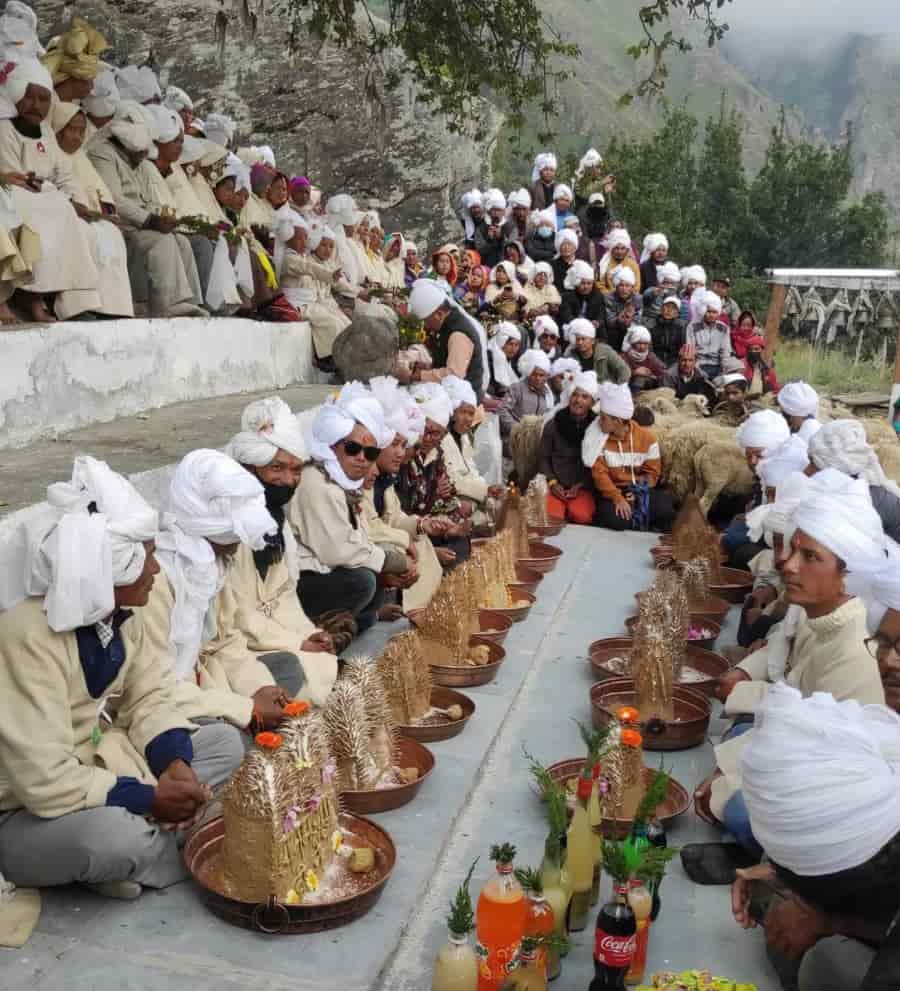
Despite the tribal population’s commitment to preserving their traditional attire, contemporary influences and globalization have gradually impacted their clothing patterns. Younger generations, in particular, have begun to adopt modern clothing due to convenience, availability, and changing tastes. This has led to concerns regarding the continuity of these traditions.
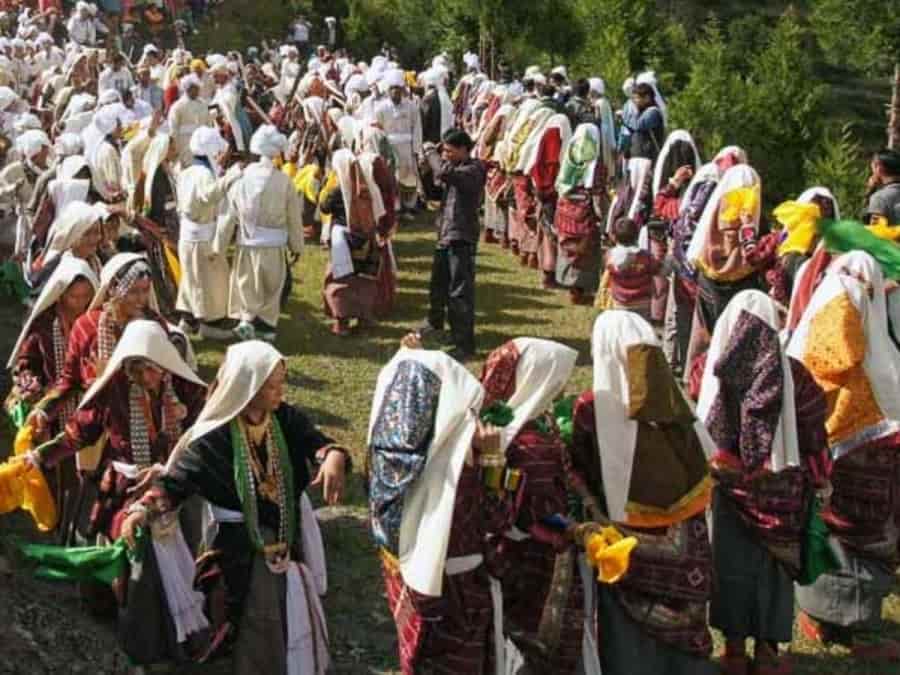
Additionally, the availability of cheaper machine-made fabrics and garments has made it challenging for traditional hand-woven textiles to compete in the market. As a result, the demand for authentic Bhotia garments has diminished, impacting the livelihood of tribal artisans.
Conclusion
Traditional clothing, textiles, and accessories hold a unique place in the cultural heritage of the Bhotia tribe in Uttarakhand. The costumes are not just material objects but living symbols of the community’s identity and history. By documenting and understanding the nuances of these traditional garments and accessories, we can help preserve and promote this valuable aspect of the Bhotia cultural heritage.
The Bhotia tribe has shown resilience in preserving its traditions, even in the face of modernization. However, to secure the future of these exquisite costumes and textiles, it is vital for government initiatives, non-governmental organizations, and society to come together to support the continuation of these age-old traditions. By doing so, we can ensure that the Bhotia tribe’s unique clothing culture endures for generations to come.

 Call
Call WhatsApp
WhatsApp Enquiry
Enquiry